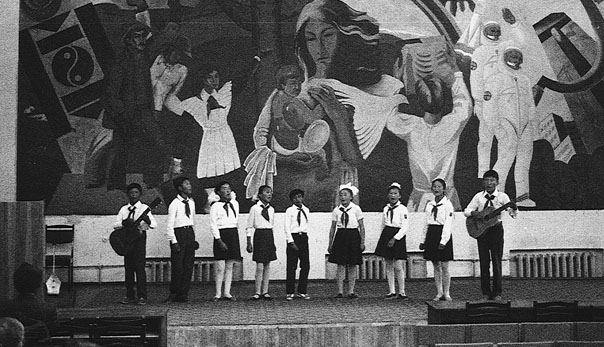| This Web book is based on public domain material provided by the US government and is available in several versions. See the editorial for more information. |

|

Home  The Society and Its Environment The Society and Its Environment  Education Education  The School System The School System |
||||||||||||||||||||||||||||||||||||||||||||||||||||||||||||
| See also: Education and Employment, Higher Education, Study in the Soviet Union, Education and Training | ||||||||||||||||||||||||||||||||||||||||||||||||||||||||||||






|
||||||||||||||||||||||||||||||||||||||||||||||||||||||||||||
The School System
Education in Mongolia traditionally was controlled by the Buddhist monasteries and was limited to monks. Tibetan was the language of instruction, the canonical and liturgical language, and it was used at the lower levels of education. Higher-level education was available in the major monasteries, and often many years were required to complete formal degrees, which included training in logic and debate. With the exception of medicine, which involved an extensive pharmacopoeia and training in herbal medicines, higher education was esoteric and unworldly. Major monasteries supported four colleges: philosophy, doctrine, and protocol; medicine; mathematics, astrology, and divination; and demonology and demon suppression. In the early twentieth century, officials and wealthy families hired tutors for their children, and government offices operated informal apprenticeships that taught the intricacies of written records, standard forms, and accounting. Official Mongolian sources, which tended to depict the prerevolutionary period as one of total backwardness, probably underestimated the level of literacy, but it was undoubtedly low.
Secular education began soon after the collapse of Chinese authority in 1911. A Mongol-language school under Russian auspices opened in Yihe Huree in 1912; much of the teaching of the forty-seven pupils was done by Buryat Mongols from Siberia. In the same year, a military school with Russian instructors opened. By 1914 a school teaching Russian to Mongolian children was operating in the capital. Its graduates, in a pattern that was to become common, went to cities in Russia for further education. Perhaps in response to the challenge of the few secular schools, monasteries in the 1920s were running schools for boys who did not have to take monastic vows. Such schools used the Mongol language and the curriculums had a heavily religious content. Education expanded slowly throughout the 1920s. As late as 1934, when 55 percent of all party members were illiterate, secular state schools enrolled only 2.7 percent of all children between the ages of eight and seventeen, while 13 percent of that age group were in monastic schools. Suppression of the monasteries in 1938 and 1939 closed the monastic schools, and the state schools expanded steadily throughout the 1940s and the 1950s. In 1941 the traditional Mongol script, based on the Uighur script, was replaced by Cyrillic. It took from 1941 to 1946 - sources differ on the date - to implement the change completely. Mongolian authorities announced that universal adult literacy had been achieved by 1968. A Russian-owned printing shop, opened in Yihe Huree in the early twentieth century, turned out Mongolian translations of Russian novels and political tracts; in 1915 it printed Mongolia's first newspaper, Niysleliyn Hureeniy Sonon Bichig (News of the Capital Huree).
For students who had completed eight years of schooling, there were two types of career-oriented schools: vocational schools (sometimes called vocational/technical schools in Mongolian publications) and specialized secondary schools. The distinction between the two was not clear. Vocational schools appeared to train more highly skilled workers, such as machinists, heavy-equipment operators, and construction workers, providing a terminal education to students who did not excel in the classroom. The specialized secondary schools, which corresponded to the Soviet technicum provided two-year or three-year courses at the junior college level. They trained paraprofessionals and technicians, such as primary school teachers, medical technicians, or bookkeepers. Students with diplomas from specialized secondary schools could apply for admission to higher education. As more funds and more technically trained teachers became available, the number of vocational schools increased. In 1988 there were 43 vocational schools, which enrolled 30,000 students in 110 fields. Specialized secondary schools offered two-year or three-year courses, and students received room and board and a monthly stipend. During their stints of practical work in factories or other enterprises, they received the normal salary for their work. The reform of secondary education under way in the 1988-89 school year called for three-year vocational courses for students with eight years of general education. Students who graduated from complete ten-year courses could spend one year in vocational schools. The ninth-year and tenth-year classes in general education schools prepared students for college admission or for generalized whitecollar work. In 1985 Mongolia had more than 900 general education schools, 40 vocational schools, 28 specialized secondary schools, 1 university, and 7 institutes. The general schools enrolled 435,900 students; vocational schools, 27,700; specialized secondary schools, 23,000; and higher education, 24,600. Women made up 63 percent of all students in higher education, and girls constituted 58 percent of students in specialized secondary schools. Women were 67 percent of all teachers in general schools, 50 percent of teachers in specialized secondary schools, and 33 percent of higher education faculty. In 1985 kindergartens, serving families in which both parents worked full time, enrolled 20 percent of the children who were three to seven years old. Education Statistics, 1970, 1980, and 1985
|
||||||||||||||||||||||||||||||||||||||||||||||||||||||||||||
Home  The Society and Its Environment The Society and Its Environment  Education Education  The School System The School System |
||||||||||||||||||||||||||||||||||||||||||||||||||||||||||||
Last Update: 2010-12-07


